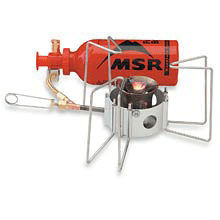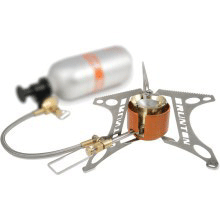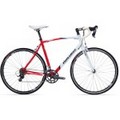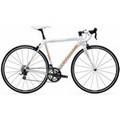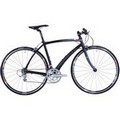What Do You Want To Know About
Bicycling Stoves?

If you plan on having a hot meal every night at camp, you are going to need a bicycling stove to round out your camping equipment. Otherwise, after a long day on the road, you will be eating cold meals or in restaurants. Cold meals get old really fast and sometimes a restaurant may not be within your day’s ride. So before picking out a bicycling stove, let’s review briefly stove capacities, features, and types of fuel burned.

Size Considerations
Lightweight stoves can be as small as a soda can to large enough to support a large pot. I would recommend that you choose the lightest and smallest stove that will handle the size of pot you plan on using. The following are some key features that I look for in a bicycling stove:
- The fuel supply and stove can be separated. Some stoves store the fuel in a fuel tank incorporated in the stove. I don’t recommend this type because I like to keep my fuel supply in one of my water bottle cages. (Not in a water bottle but in a specialized fuel bottle.) This way if the fuel leaks while on the road, your panniers and clothes won’t smell of fuel for weeks.
- The ability to collapse into the smallest space possible is crucial for me. I store my stove in a leak-proof bag in my pannier. I like for legs to be folded in so that no sharp or pointed objects can puncture the bag or damage surrounding articles. Some stoves can fold up small enough to fit inside your largest pot. This can be a great space saver and protection for the stove in case of a fall.
- And the lightest weight possible should be a prime consideration. But you don’t want it to be too light to support your largest pot. So when considering weight, you need to weigh in the stability of the stove.
Performance
Size of the stove, fuel pressure, and type of fuel determine the performance characteristics. Some stove use the heat from cooking for increasing the fuel pressure, which means that performance increases with cooking time. Other stove incorporate a pumping system to kick start the fuel pressure, thus reducing the time to full performance. I prefer a pumping system, especially for getting a stove started on a cold morning. When you compare stove models, there are three important performance data:
- The average time a stove takes to boil 1 liter of water at 70°F at sea level is the most important bit of information. The type of fuel that the stove burns affects this data. White gas stoves should have a average boil time less than kerosene, butane and denatured alcohol. A good rule of thumb would be for a white gas stove to have a average boil time between 3.5 to 4 minutes. Also, as you gain altitude, the average boil time will increase due to the thinner air.
- The amount of water boiled per pint of fuel. Again, the type of fuel burned affects this time. A good rule of thumb time for a stove with white gas should be around 7 or 8 liters (14.5 to 17 pints) of water. The more water the stove can burn per amount of fuel reduces the amount of fuel you need to carry before refilling.
- The total time that the stove can burn at maximum flame. For stoves with separate fuel canisters, this information is not as important since you can increase the canister size if needed. For stoves with internal fuel tanks, the greater the time, then the less times you will need to refuel. Refueling during actual cooking time can be a problem since the stove will be too hot to handle and too dangerous to refuel until it cools down.
The performance of all stoves can be improved by following a few easy steps:
- Clean and maintain your stove. Some stoves have self-cleaning jets. Even with these stoves, you will need to clean it on a regular basis.
- Use a windscreen and heat reflector.
- Filter all fuels before or during filling of the fuel canister.
- Yes, a covered pot boils water quicker.
Fuel Options
The choice for types of fuel depends on the availability of fuel at your camping locations. Also, each fuel type have different heating values that affect the performance of your stove. Some stoves are single fuel types and others are multiple fuel options. I prefer the multi-fuel types for a bicycling stove due to its versatility in many different countries. So let’s look at some of the available fuel options and the advantages and disadvantages.
- Wood: Wood is a fuel source that is available in some form or another about everywhere. I am not talking about building a large fire, which is very negative to the environment. With the advent of numerous small wood chip burning stoves on the market today, then wood is an excellent fuel alternative.
- White gas: In North America, it is the fuel of choice, but it can be hard to find elsewhere. White gas burns very clean, ignites quickly, and is inexpensive and easy to find. In fact, you can find it in most tourist locations, small and large town, camping stores, convenience stores, and hardware stores. It is very volatile, so you need to be careful if you spill the fuel.
- Kerosene: Throughout the world, kerosene is fairly easy to find. Many countries use kerosene for heating so it can be abundant in some countries and can be inexpensive. Unfortunately, it burns dirty (you will have to clean your stove often), bothers many people due to it smell, and can be fairly messy. You will definitely need to filter the fuel, especially in many countries. Kerosene, however, has a high heat output and spilled fuel does not ignite quickly.
- Butane, propane, and/or blended canisters: What is nice about these preloaded canisters is that you don’t have to mess with the fuel. It is very convenient to use, very clean burning, burns hot quickly, and ignites easily. The bad news, in my opinion, outweighs the positives. You must carry the heavy canisters and dispose of them properly. Performance decreases significantly with decreasing temperatures. Propane will work to about 0°F and butane above 32°F. The blended fuels somewhere in between 0°F and 32°F.
- Denatured alcohol: Alcohol-burning stoves have few moving parts and denature alcohol is a ‘green’ fuel. It is a environmentally friendly fuel option in North America and it is a clean and quiet burning fuel. It does not ignite easily if spilled, but the light blue flame can be almost invisible under certain conditions. Unfortunately, denatured alcohol has a low heat output so boiling water times may be quite high.
- Unleaded gas: It is easy to find, inexpensive and can be found throughout the world. However, it is extremely dangerous if spilled, burns very dirty, and should be used only as a last resort.
Stove Reviews
MSR Dragonfly Stove
For the international backpacking gourmet, the multi-fuel MSR DragonFly stove has the most adjustable flame of any liquid fuel burning stove. It can be quite loud at full flame. Two control valves: one to regulate gas flow and another to dial-in a precise flame. Burns almost any fuel, including white gas, kerosene, diesel, automotive gas, aviation gas, stoddard solvent and naphtha. Field-maintainable stove stays clog-free thanks to its self-cleaning jet. Legs spring open for ease of use and fold compactly for storage–fits inside MSR cook sets. Weighs about 1 lb. plus fuel and fuel container.
Sierra Wood Stove
The Sierra burns twigs, bark, pine cones and other woods readily available around a campsite, as well as charcoal and other solid fuels. The Sierra incorporates an adjustable speed fan, creating a forced ventilation system that provides intense heat and efficient burning. It weighs only 1 lb yet creates up to 18,000 BTU/hr, enough heat to boil a quart of water in four minutes.
Brunton Vapor AF Stove
The Vapor AF stove accepts multiple fuels to keep you cooking anywhere in the world. Precision simmering control makes it easy to simmer and saute with out completely scorching your meal. On high boil it is loud, but extremely hot. Flip-stop fuel pump purges fuel from the fuel line, eliminating fuel spillage when uncoupling the stove from the bottle. Expensive, but one of the best lightweight stoves on the market.
